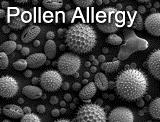Pollen allergy is one of the most common kinds of allergies.

Pollen is produced by trees, grasses, and weeds. Different plants produce pollen at different times of years, including the spring, summer and fall.
Allergy symptoms worsen as the concentrations of pollen increases in the air.
Each person is allergic to one or more type of pollen. Those allergic to just one type of weed pollen may experience allergy symptoms for only a few weeks each year when that weed is pollinating. However, many people are allergic to many types of pollen. Those who are allergic to multiple pollens may suffer from allergy symptoms for most of the year.
Weed Pollen Allergies (Rageweed, Curly Dock, Pigweed, Others)
Ragweed and other weeds such as curly dock, lambs quarters, pigweed, plantain, sheep sorrel and sagebrush produce large volumes of pollens likely to trigger allergies. Ragweed pollen season runs from August to November and usually peaks in mid-September in most areas in the country.
Weed pollen counts are highest between 5 - 10 AM and on dry, hot and windy days.
Grass Pollen Allergies
Grass pollen concentrations vary by region and its levels are affected by temperature, time of day and rain. Of the more than 1,000 species of grass that grow in the U.S. only a small percentage produce pollens that trigger allergies. The grasses most commonly associated with allergies include:
- Bermuda grass
- Johnson grass
- Kentucky bluegrass
- Orchard grass
- Sweet vernal grass
- Timothy grass
Tree Pollen Allergies
Trees produce pollen early in the allergy season that can be distributed many miles away.. Trees tend to pollinate as early as January in the Southern states and as late as May or June in the Northern states.Types of trees that commonly trigger allergies include:
- catalpa
- elm
- hickory
- olive
- pecan
- sycamore
- walnut
Some people show cross-reactivity to tree pollens in the alder, beech, birch and oak family, and the juniper and cedar family.
Pollen Allergy Prevention Tips
- Avoid the outdoors between 5-10 AM.
- Save outside activities for late afternoon or after a heavy rain, when pollen levels are lower.
- Keep windows in your home and car closed to lower exposure to pollen.
- To keep cool, use air conditioners and avoid using window and attic fans.
- Be aware that pollen can also be transported indoors on people and pets.
- Dry your clothes in an automatic dryer rather than hanging them outside where they might collect pollen.
- Grass allergy: If you have a grass lawn, have someone else do the mowing. If you must mow the lawn yourself, wear a mask. Keep grass cut short.
- Grass allergy: Choose ground covers that don't produce much pollen, such as Irish moss, bunch, and dichondra.
- Tree allergy: If you buy trees for your yard, look for species that do not aggravate allergies such as crape myrtle, dogwood, fig, fir, palm, pear, plum, redbud and redwood trees or the females of ash, box elder, cottonwood, maple, palm, poplar or willow trees.
How can I tell whether I have a cold or a pollen allergy?
At first it may seem tricky to tell the difference between a cold and hay fever when some of the symptoms are the same, such as water eyes, runny nose, and sneezing. However, there are some key differences:
- A cold will often include fever and aches and pains.
- Exposure to the virus that causes a cold will often not produce symptoms for several days; exposure to pollen allergens usually triggers symptoms right away.
- Cold symptoms should go away within a week; hay fever symptoms will last as long as you are around the allergen.
Source: Vivacare
Last updated : 1/8/2019